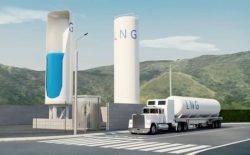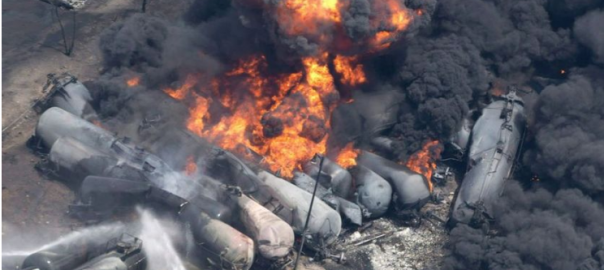The Plan We Must Stop
This is the beginning of a series of blogs to educate the public about the dangers of LNG as well as to convince as many people that we can to object to this dangerous precedent by providing information about what LNG is and what you can do.

Liquefied Natural Gas or LNG and the proposed DOE rule that would allow unregulated, with no agency oversight, small scale processing facilities to pop up in your neighborhood endangering you, family, friends. By allowing LNG processing to be your neighbor, pass you in a semi, or be on the same train as you commute, or simply passing through the area you live in, you are at great risk. We encourage you to comment to the Federal Registry Public Comment Concerning Unregulated Small Scale LNG Processing Facilities.
This a very dangerous and unhealthy addition of unregulated
with no agency oversight infrastructure to export and transport fracked gas from fracked gas pipelines such as the Sabal Trail Pipeline and others. The comment period for the public – in link above – is for you to have input as to whether fracked natural unregulated, small-scale LNG processing facilities should be approved. Please take this opportunity to answer with a resounding NO! These new small scale LNG facilities that are now being ‘pushed’ by our government via executive order by President Trump on this past Labor Day and with the blessing of invested Governor Rick Scott will affect all Floridians as well as all areas of the USA.
There are already LNG ‘gas stations’ in Georgia for instance and I am sure across the country as UPS is using LNG to run their semis. Did they forget hydrogen like Norway and Germany use?
The plan is to reduce volume or capacity of fracked gas by converting it to a liquid state, an unstable state, called LNG which makes for easier transportation and storage via train, ships and trucks all over the USA with the proposed, unregulated small-scale processing plants being located near pipelines and inland ‘ports’ in populated areas – such as Miami, Orlando, Jacksonville FL (Jaxport) – all across Florida and the USA.
Sabal Trail Transmission, LLC or rather parent companies, NextEra, FPL, Duke Energy along with TECO (Tampa Electric Co.) plan to build another pipeline in Suwannee County’s Springs Heartland whose land mass is a major recharge/discharge area for the Floridan Aquifer which is the sole source of water for millions of people. This pipeline will feed off to Jacksonville, Fla and is only located 1/2 mile form the world famous Ichetucknee River! From WWALS “Crowley Maritime’s Carib Energy is already exporting LNG from Jacksonville, and is authorized to get LNG from both Floridian Natural Gas (FLiNG) in Martin County at the end of the Transco → Sabal Trail → FSC pipeline chain, and from Florida Gas Transportation (FGT)’s Jacksonville Expansion Project from Sabal Trail in Suwannee County to Jacksonville.” To read more about these approved export terminals with maps please visit WWALS blog site by clicking here.*
The plan for Florida is to transport fracked natural gas to Jacksonville Fla and various other ports along both of Florida’s coastlines for export to non-FTA (Free Trade Agreement) countries. There will also be transport via railway per permits some already granted by DOE. Florida East Coast Railway (Approved), Alaska Railroad (Approved) and All Aboard Florida’s planned high speed commuter railway from Miami to Orlando (More than likely will be approved) according to Hannah Wiseman, Florida State University College of Law professor in TCPalm Story on LNG Transport by Train. Also here in another TCPalm Story “The dangers of liquefied natural gas would increase when All Aboard Florida’s Brightline trains begin using the same tracks for 16 plus daily passenger round trips between Miami and Orlando, according to Wouters. Construction of Brightline already has begun between Miami and West Palm Beach, and service there is to begin in early 2017, with full service beginning in late 2017.”
Transportation of fracked gas from these small scale processing plants will be both for export to other countries and transported to various ports across Florida and the rest of the USA inland on our highways via truck and via trains, creating what are commonly referred to as bomb trains and bomb trucks because of the instability of LNG.
This proposed process will begin, if we do not stop it, as fracked gas is delivered to small-scale inland LNG Processing Facilities via gas pipelines such as the Sabal Trail Pipeline (Straight from the Marcellus Fracking fields) which spans 515 miles from Alabama, through Georgia and into Florida where these unregulated inland processing plants are to be built in populated areas just as they are in other export areas of the country. These are the same areas from which the gas will be transported by truck or train to export terminals.
Note that export of LNG to other countries by large port terminals has already begun in Jacksonville and Hialeah Fla. The proposed Titusville Fla. export terminal which is owned by subsidiaries of Fortress Investment Group — parent company of All Aboard Florida and Florida East Coast Railway — “within seven years could build, own and operate a liquefied natural gas facility in Titusville, according to a free-trade agreement approved May 29 by the federal Department of Energy” – This approved by DOE in 2015 would increase tenfold the amount of LNG traveling our railways in Florida and has come to pass in Florida. About 30 billion cubic feet of liquefied natural gas could be transported annually along the 351-mile Jacksonville-to-Miami rail corridor! More on this story here. Additional export stations are popping up all up and down coastal areas of Florida, Louisiana, Texas, Maryland, Oregon, Alaska and more.
Cecile Scofield of Florida, is an expert on the subject of LNG export terminals and can be credited with halting Hess from building an LNG terminal in Boston. Watch her very informative video filmed at a recent WWALS/Suwannee Riverkeeper event in Live Oak Florida here.
Please continue reading to understand exactly what LNG is and the threats it is to our very lives. If additional unregulated small scale operations for processing LNG with zero oversight is allowed then we are will see even greater dangers to our lives, water and ecology.
What is LNG & What Are Its Properties*
The process of liquefying natural gas is to reduce the volume of natural (fracked) gas to facilitate storage and transportation. This process causes instability and increases the dangers of transporting natural/fracked gas by expanding from pipelines to our railways and roadways.
LNG Facts
- Fracked Natural Gas is cooled to -259°F creating a cryogenic fluid known as LNG
- Primary component is Methane – which is composed of some additional very toxic chemicals
- LNG occupies 1/600 of the volume of natural gas in it’s normal state – think very concentrated and unstable
- LNG Has 600 times the energy of natural gas
- Extremely Flammable
- Easily ignited by heat, sparks, or flames
- Forms explosive mixtures with exposure to air
- Vapors may travel back to source of ignition and flashback
- Cylinders to exposed to fire may vent and release flammable gas through pressure release valves
- Heat may cause LNG containers to explode
- Ruptured cylinders can behave as rockets
- A flammable vapor cloud formed when liquefied natural gas spills and begins to evaporate but does not ignite also poses danger, including the risk of asphyxiation
- Contact with water can result in violent boiling of LNG and cause extreme, rapid vaporization
- If liquid ( think condensation etc) makes contact with LNG in closed containers pressure will build to extreme levels – thus the terms bomb trains bomb trucks
- Because LNG pool fires are so hot, their thermal radiation may injure people and damage property a considerable distance from the fire itself
Safety Concerns Of Breached LNG Containment Tanks
- First a flammable vapor Cloud will form
- LNG boils very quickly and vaporizes
- A flammable natural gas gas vapor/air mixture cloud forms
- Very high likelihood of ignition from electrical sparking, static electricity, etc. LNG is highly volatile and flammable – more so than natural gas
- Flash Fires
- Vapor cloud denser than ambient air will form & be dispersed by prevailing winds
- Will easily explode if in controlled areas
- No regulation – as proposed in these small-scale unregulated processing plants means that a LNG ‘breach’ can travel to adjoining homes, businesses anywhere
- A flammable vapor cloud formed when liquefied natural gas spills and begins to evaporate but does not ignite also poses danger, including the risk of asphyxiation
- Liquefied natural gas fires cannot be extinguished; all the natural gas must be consumed before the fire will go out
- Run like Hell!
What happens in a LNG Spill
- Thermal radiation (extreme heat) from fire
- A large bright flame will form above the pool of vaporizing LNG
- The heat is approximately 60% greater than a gasoline fueled fire
- Poses significant hazard to nearby people and property
- Run like hell!
- Since these small scale operations are unregulated there are no legal provisions for the property of others
We will be blogging more on this subject with expert input on points to address in your comment to the Federal Registry (DOE) as well as a sample comment for you to follow. Folks this is just as bad if not worse than the Sabal Trail Pipeline and others across the nation.
Please share this blog via email, Facebook, Twitter, etc. Thank you!
*Thank you to WWALS.net and Cecile Scofield for providing some of their valuable information contained in this blog.
~~Deb
Short Link:

People refuse to believe Science. My father died in a mine explosion in WVA. Methane is a KILLER, but oil, gas barrons don’t care. They just collect the check, they are not placed in danger. Sad what our country and the world has come too.
Yes you are correct Pam. I am saddened to hear about the death of your father in a methane induced mine explosion.
Oil and gas companies as well as most every large corporation are all about the money. Human lives mean nothing to those that run these companies. Just the bottom line.
Thank you for your comment.
Debra Johnson
We also are not prepared for an emergency involving large amounts of people and property. Even when given warnings like when natural disasters occur, systems are overwhelmed in both response and after effects. Many small and even large agencies are unaware that these disastrous events are so close to occurring. An accident would be a disaster; a planned incident would be catastrophic.
You are exactly correct Ms. Gray. As seen in the link below in Martin County Fl whose officials are very concerned and estimate a tenfold increase in rail transportation should these inland LNG Terminals be approved. None of the emergency agencies in Fla are prepared for a pipeline or LNG transportation incident as fracked natural gas explosions can not be extinguished – the gas has to burn off. Once one blows the only advice is, if you are not incinerated is to “Run like hell”. Thank you for your comment!
https://www.martin.fl.us/sites/default/files/meta_page_files/Presentation_Report%20AAF%20LNG%20Vulnerability%20Final_12_15_15.pdf
Not only that, many of the counties that they are transporting liquified and compressed gas through have little awareness of that fact- much less a comprehensive disaster and response plan that will be appropriate. In some areas of rural Florida it takes 20 minutes to even mobilize the response and rescue personnel- and that is for a car accident.